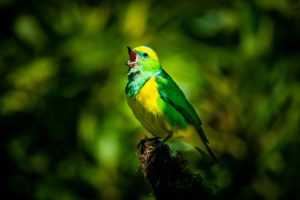I have been reflecting on the different sounds that surround the growing realization that we are living in an interdependent world. For example, anyone following the mask debate knows that the tensions between autonomy and interdependence can be loud and jarring; filled with emotions and reactive leadership. What we might not understand is that this “noise” in the larger system is the early sound of realizing that we are all connected.
The noise comes from people who live along a continuum of separation to connection. At one end, people are seeing the world as separate, and that any expectation of interdependence or connection is taking something away from the individual’s freedom and choices. The other end of the continuum sees the world, communities, and nature as all connected in a deeply interdependent way. These folks understand that individual actions will ripple across all the connections in expected and unexpected ways. In an interdependent system, individual actions can create consequences at a distance.
In the middle of this continuum are people who can see the connections in certain domains of their lives (like the global economy and the stock market) but may not see the interdependence in other ways (like climate change being impacted by individual actions).
The different sounds of interdependence
I flew on a plane recently for the first time in the last 18 months to spend time in Hawaii. This trip afforded a lot of observations on the different sounds of interdependence. For example, flying assumes that all the different people getting on a plane from one place to another are working together in a seamless way to connect people to the places they are going. Stop and think for a moment about all the moving parts that need to be coordinated: plane maintenance, gate personnel, computer systems, purchasing tickets, pilots depending on air traffic control, and routing maps to reach their destination safely. Weather systems need to be continually updated to allow for smooth adaptation flight plans, all the ground personnel that fuel, dock, load and unload baggage all need to be working together to ensure our airports are operating effectively.
It is mind-boggling how many individuals are working together with many small and large systems to seamlessly integrate all the individual actions into a collective purpose – facilitating plane travel. This example of interdependence is often taken for granted. It is like a quiet hum in the background and the only time we really notice how elegant the dance is; is when something goes wrong. So, in air travel, we notice the absence of interdependence and we take for granted the deep interdependence that is on display. This kind of interdependence occurs in our supply lines, in the fluid movements of a great restaurant, and in great organizational teams.
However, we also have examples of situations where those involved don’t want to see or adapt their behaviors to the reality of interdependence. Examples are a team filled with people who don’t want to work together or an organization attached to silos between departments. The sounds of this kind of interdependence are the sounds associated with conflict, stress, and tensions. It is noisy!
The good news is that as people and divisional leaders strengthen their appreciation and understanding of how they are working in an interdependent world – the noise of denying interdependence disappears. When the connection is understood, more people on the team and/or organization shift their behavior to align with the reality of interdependence.
Now I notice the noise level surrounding the way people make meaning of their situation. If it is noisy, then people are denying the connectivity of the system. If there is a quiet hum in the background, then people are behaving in a way that acknowledges that they all are interdependent.
A simple diagnostic
The more conflict, the fewer people are able to see interdependence and the collective whole. Conflict is a result of people struggling to see the interdependent world we are living in. It is a leader’s job to help people shift their worldview from separation to connection!







Excellent. We recently hosted a family gathering. I noted that, without saying anything, we set up and cleaned up soundlessly and efficiently.
Systemic integration and interdependence require leaders to lead people, systems, processes towards seamless coordination, problem-solving, and change. As a small nation and city-state like Singapore, we understood our impact on issues such as the pandemic and climate change but we strive to be interdependent as nation citizens; and in a small way be integrated and connected to the region and the world.
“A continuum from separation to connection”. Very helpful.
Well put across. It all bottles down to leadership.